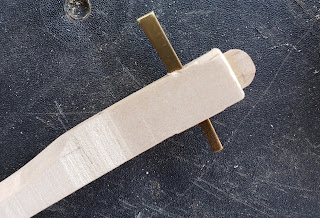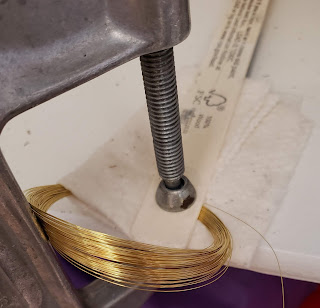This little instrument holds its tune amazingly well. A few tweaks here and there were needed, but overall, it doesn't require frequent tuning like my harpsichords did. And the best part is that after I set the temperament, trying to stick to the naturals only as much as possible, and tuned octaves, the sharps pretty much fell into place. For those that needed a tweak, I simply bent the tangent a tiny bit one way or the other. Voila!
Now, how do you set that temperament, you may ask. Good question. I'm not going to be much help to you, I'm afraid. After reading all my options, I decided to go with what I know and fall back on my harpsichord skills, set an even temperament (which the manual really discourages), and see what would happen. This decision was made based on the fact that I do occasionally like to play contemporary repertoire. And, if I'm being completely honest, the other options made my head swim.
I picked a pitch to call "A" (I opted to get fairly close to 440). Since this is strictly a solo instrument, an instrument upon which to practice by myself, tuning exactly to A440 is not required. But I still wanted to be fairly close. From there, I tuned wide fourths and narrow fifths. I listened for beats. When I heard the wah-wah of the interval go completely dead, I knew I had a perfect interval. In the case of a fifth, I then tuned that new note a smidge flat - just a hair. I did the same with fourths except I tuned it a hair sharp. When I had set all the fourths and fifths in the center of the keyboard, I then tuned octaves so that they were without any beats, or wah-wahs, whatsoever. For example, when you play your A440 and the A an octave higher together at the same time, you'll hear some beats, like a vibrato. But as you tune that upper A, eventually those beats become slower (to my way of backwards thinking, wider apart) until suddenly, they just disappear. That's when you've tuned the octave perfectly. Then you move on to the next note.
Learning this skill did not come to me overnight. As an undergraduate, I practiced my tuning skills a lot on the school's harpsichord. Early on, I suffered practice with a very imperfectly tuned instrument and depended on my teacher to handle the tuning when time permitted. But eventually, I got the hang of it and remember feeling pretty proud of myself the first time it sounded good. But what did I know? I clearly recall walking into my next harpsichord lesson and my professor asking me if I had tuned the harpsichord. At the time, I was probably the only harpsichord student, so it was either me or the luck of temperature and humidity that worked some pretty fancy magic. I admitted that I had indeed tuned it (with the help of a few glasses of wine, although I did not confess that bit). He said, "It's very well tuned, Debbie. Good job!" So that helped nail the A that semester. I think the wine helped also.
So this is the end of my clavichord saga, although I'm perfectly aware that it will never really be finished. It took me forever to accomplish this because life managed to get in the way. But it's done, and while it is far from perfect, it is mine!


































